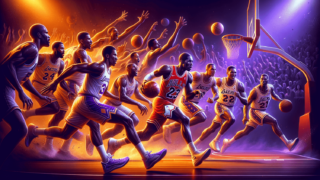
Impact of the Three-Point Revolution on Basketball Strategy
Written by: Basketball Universe
Last updated:

In the ever-evolving world of basketball, few innovations have shaped the game quite like the three-point revolution. This seismic shift in strategy has transformed the hardwood landscape, redefining the way players and coaches approach this beloved sport. For those of you eager to delve into the nitty-gritty details of this intriguing metamorphosis, you’re in the right place! In this fun and professional analysis, we’ll dissect the dramatic impact that the three-point revolution has had on basketball strategy, examining how it has changed offensive and defensive tactics, elevated the importance of sharpshooters, and infused the game with a thrilling, unpredictable dynamic. Fasten your high-tops and let’s embark on this fascinating journey!
Impact of the Three-Point Revolution on Basketball Strategy
The three-point revolution has significantly affected basketball strategy by placing an increased emphasis on three-point shooting, redefining player roles, and making floor spacing and analytics more critical than ever. As teams and players prioritize long-range shots, offensive and defensive tactics have shifted to exploit or defend against these high-value scoring opportunities. Traditional frontcourt players have also evolved, with many now possessing outside shooting skills to help spread the floor and create space for drives, cuts, and open shots. Consequently, this revolution has accelerated the fusion of data and analytics with on-court performance, leading teams to adapt their decision-making and roster-building process to maximize efficiency and effectiveness.
Three-Point Shooting: Changing the Game from the Arc
The fundamental transformation brought about by the three-point revolution in basketball can be traced back to the increased focus on three-point shooting. As teams began to recognize the inherent value of scoring from beyond the arc, they turned to the numbers and found that three-pointers offered a remarkable competitive advantage. With every successful shot yielding an extra point, the long-range game has revolutionized basketball; it has become an optimal strategy for maximizing points and maximizing wins.
The Numbers Game: Analytics Take Center Stage
In the world of basketball, nothing speaks louder than cold, hard facts. The three-point revolution is all about leveraging the potential of analytics, as teams, coaches, and players seek to fine-tune their strategies for maximum impact. Advanced metrics provide valuable insights, helping teams identify new opportunities for scoring and the importance of floor spacing. In this new era of basketball history, data-driven decision-making takes center stage, guiding everything from roster selection to play execution.
Developing Three-Point Specialists
As three-point shooting becomes a critical battlefield in the modern game, players who excel in this area are in higher demand than ever before. Teams are now focusing on developing or acquiring sharpshooters who can consistently drain shots from beyond the arc. The three-point revolution has not only redefined the way offenses operate but has also played a pivotal role in shaping the identities and careers of countless players.
Stretch Bigs: Redefining Roles and Responsibilities
One of the most fascinating aspects of the three-point revolution is the transformative effect it has had on various player roles, particularly in the frontcourt. Traditional big men, once confined to the low post and paint regions, have now expanded their skillsets to become ‘stretch bigs.’ These versatile players can nail shots from long range, demand defensive attention, and spread the floor, disrupting opponents’ defensive schemes in the process.
Evolution of the Modern Big Man
As the value of three-point shooting continues to rise, big men in the game have been forced to adapt or risk obsolescence. With the increasing requirement for floor spacing both to maximize shot efficiency and to create lanes for ball-handlers to drive, the modern big man no longer serves solely as a post threat. Instead, they need to satisfy a more diverse array of responsibilities, which often includes contributing from beyond the arc.
Embracing Versatility
Some of the game’s most notable stretch bigs have embraced the three-point revolution, transforming their careers and altering their team’s fate in the process. Players like Dirk Nowitzki, Kevin Love, and Kristaps Porziņģis, among others, have made a name for themselves by fusing size, skill, and shooting prowess. This exciting mix has reforged the mold of a traditional big man while redefining what it means to be a dominant force on the court.
Altered Offensive Schemes: A World Beyond the Arc
With a renewed emphasis on the long-range game, offensive schemes have undergone a substantial metamorphosis. The three-point revolution has forced coaches and strategists to radically rethink their game plans, opening up a world of possibilities for imaginative and innovative play.
Pace and Space: A Modern Approach to Offense
One of the key byproducts of the three-point revolution has been the rise of pace-and-space offenses. In this strategy, teams prioritize pushing the ball down the court in transition, spreading out their players, and utilizing quick passes to create open looks for three-point shooters. By increasing the tempo and making the most of the court’s entire surface, this approach keeps defenses on their toes and provides a compelling blueprint for scoring success.
Death Lineups: Small Ball Strikes Back
Another intriguing development in offensive schemes stemming from the three-point revolution is the emergence of so-called ‘death lineups.’ These involve teams deploying players who can shoot from distance, often at the cost of sacrificing size and traditional positional concepts. This small-ball approach is designed to create mismatches, space the floor, and exploit gaps in the defense, which can lead to wide-open three-point attempts or drive-and-kick plays.
Ball Movement and Off-Ball Activity
In an era of high-level three-point shooting, solid ball movement and relentless off-ball activity have become central tenets of modern offensive schemes. Players must continuously cut, screen, and move with purpose to create open shots from distance. Meanwhile, crisp and accurate passing becomes vital to capitalizing on teammates’ movements, maximizing team three-point shooting opportunities.
Transformed Defensive Tactics: Battling the Beyond-the-Arc Barrage
With the arrival of the three-point revolution, defenses have been forced to adapt their tactics to counter the growing threat of long-range shooting. Opponents must now devise creative ways to stifle the high-value scoring onslaught while remaining watertight at the back.
Switching Defenses: Adapting to the Three-Point Threat
In response to the myriad challenges posed by proficient three-point shooting teams, coaches have increasingly opted for switching defenses. In this approach, defenders quickly swap assignments on screens and off-ball actions to prevent open three-point shots. While this method sacrifices traditional positional matchups, it provides an effective means of closing out on shooters and disrupting offensive flow.
Perimeter Pressure: An Essential Component
Another critical defensive tactic in neutralizing potent three-point attacks is relentless perimeter pressure. By switching on screens and staying glued to shooters, defenders force opponents to put the ball on the floor, drive towards the paint, or pass to a less favorable option. In the era of the three-point revolution, defense has become an exercise in calculated risk-taking, as teams prioritize shutting down the arc above all else.
Having explored the various facets of the three-point revolution’s impact on basketball strategy, it’s clear the game will continue to evolve, shaped by the pursuit of efficiency, versatility, and innovation. At its core, the three-point revolution has breathed new life into the sport, ensuring that basketball remains a captivating spectacle for fans and a challenging endeavor for its practitioners.
Unlocking the Three-Point Potential: Player Development and Coaching Philosophy
The three-point revolution’s impact extends far beyond the surface-level strategies and tactics discussed so far. Player development and coaching philosophies have also experienced profound shifts, as the basketball community at large seeks to harness the full potential of the three-point shot.
Cultivating a Three-Point Mindset: Building Confidence from Distance
For players to excel in the three-point era, they need more than just technical prowess. Cultivating a strong mental approach and unwavering confidence in their shooting ability is equally crucial. Coaches and trainers play a vital role in fostering this mindset within their players, encouraging them to embrace the three-point shot and pushing them to hone their outside shooting skills relentlessly.
Focus on Fundamentals: Shooting Drills and Techniques
As the value of three-point shooting continues to grow in the modern game, so too does the importance of mastering the fundamentals. Players must commit to refining their shooting technique, balance, and footwork, enabling them to consistently connect from beyond the arc. Coaches and trainers must emphasize the significance of impeccable shooting mechanics and encourage good habits through targeted drills and exercises.
Scouting and Player Evaluation
The three-point revolution has had a significant influence on scouting and player evaluation processes. As the league heavily values shooting, scouts now pay keen attention to prospects’ three-point shooting ability, along with their potential to develop into sharpshooters. This extra focus plays a significant role in determining a player’s draft status and long-term viability in the league.
The Global Impact: Three-Point Revolution Transcends Borders
The three-point revolution has not only influenced basketball strategy within the NBA but also transgressed geographical borders, leaving its mark on the international game.
FIBA and International Adaptation
As the NBA embraces the three-point shot with open arms, other basketball organizations, including FIBA, have followed suit. National teams and international leagues have readily adopted new offensive and defensive strategies rooted in exploiting or negating the three-point revolution, showcasing how deeply ingrained this trend has become on the global stage.
Role of International Players in the Revolution
International players have played a significant part in popularizing and advancing the three-point revolution. With their diverse skillsets and unique talents, many foreign players seamlessly fit the mold of the stretch big or the versatile wing, epitomizing the ideal three-point shooting weapon. Consequently, their contributions have further broadened the game’s horizons and allowed the influence of the three-point revolution to expand across continents.
In conclusion, the impact of the three-point revolution on basketball strategy is deep-rooted and far-reaching, enveloping every aspect of the sport, from floor tactics to player development, scouting to the international game. As basketball continues to grow and evolve, the three-point shot remains a cornerstone of the game, ushering in a dynamic, exciting era for fans and players worldwide.
FAQ: Impact of the Three-Point Revolution on Basketball Strategy
Need quick answers to your most pressing questions about the three-point revolution and how it affects basketball strategy? Dive into our comprehensive FAQ section to clear up any queries and help you gain a deeper understanding of this game-changing phenomenon!
1. What is the three-point revolution?
The three-point revolution refers to the drastic shift in basketball strategy that prioritizes three-point shooting over other types of scoring. This change is driven by the higher value of successful three-point shots compared to two-point shots and the impact it has had on player development, coaching tactics, and overall gameplay.
2. When did the three-point revolution begin?
While the three-point line was introduced to the NBA in the 1979-1980 season, the true three-point revolution began in the early 2010s, around the same time when advanced analytics started to emerge, showing the importance of efficient scoring and floor spacing using three-pointers as a critical weapon.
3. How has the three-point revolution affected player roles?
The revolution has led to the emergence of new player roles, such as stretch bigs, who combine size with perimeter shooting ability. It has also made three-point shooting prowess a highly valuable skill for players across all positions, reshaping the way basketball players are developed and evaluated at all levels.
4. What is a “stretch big”?
A “stretch big” is a frontcourt player, such as a power forward or center, who can effectively shoot from beyond the three-point line. This versatile player can spread the floor and force opposing defenses to cover more space, thus creating mismatch opportunities and open shots for teammates.
5. How has the offensive strategy changed due to the three-point revolution?
Offensive strategies have evolved to emphasize pace, spacing, and ball movement, with the goal of creating open three-point shots or driving lanes. Teams may deploy smaller lineups and lean towards small-ball tactics, prioritizing shooting and speed over size and traditional positional matchups.
6. How has defense adapted to the three-point revolution?
Defensive tactics have shifted to focus on contesting three-point shots and closing out on shooters by employing a switching defense and applying pressure on the perimeter. Defenders must also work to limit catch-and-shoot or drive-and-kick opportunities for opponents.
7. What role do analytics play in the three-point revolution?
Advanced analytics have been a driving force behind the revolution, as teams and coaches rely on data-driven insights to influence player development, roster-building, and decision-making. This focus on metrics and efficiency has made three-point shooting a centerpiece of modern basketball strategy.
8. Which players are prime examples of the three-point revolution’s impact?
Notable examples include Stephen Curry, Klay Thompson, James Harden, Dirk Nowitzki, and Kevin Durant. These players have excelled in making three-pointers, often breaking records and influencing a new generation of players to develop long-range shooting skills.
9. How has the three-point revolution affected international basketball?
The revolution has influenced the global game by inspiring national teams, international leagues, and players to adapt and evolve their strategies and skillsets in line with the three-point trend. International players have also played a pivotal role in spreading the revolution’s influence across borders.
10. Will the importance of the three-pointer continue to grow?
While it’s difficult to predict the future of basketball, the importance of the three-pointer is likely to continue growing as long as advanced analytics demonstrate its efficiency value. However, the sport evolves over time, and new strategies or innovations may emerge, leading to potential shifts in playing styles and priorities.
Featured Posts
- No pillar pages found.




